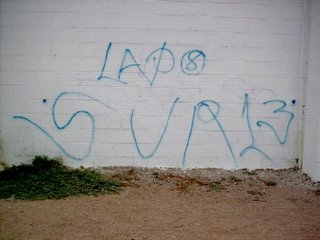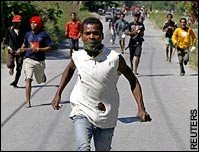http://www.suntimes.com/output/news/cst-nws-gang19.htmlGangs widening suburban reach
June 19, 2006
BY FRANK MAIN Crime Reporter
The average leader of a Chicago street gang is 43, and more often than not he lives in the leafy suburbs of Cook County.
He typically has been convicted of murder.
In some gangs, his underlings have tried to infiltrate the Cook County Clerk's office; the Cook County Sheriff's office; the Chicago Police Department, and even the College of DuPage's criminal justice classes.
Directing troops from prison
When he winds up behind bars, he communicates with his gang soldiers through a number of ingenious methods: he may write letters in urine, a secret ink that becomes visible when exposed to heat; he may send messages in "micro-writing" in languages like Swahili and runic, and he may subpoena fellow gang members to appear at his court hearings and give them orders through hand signals.
In a few instances, his gang has even communicated on radio stations. Marvel Thompson, a Black Disciples leader awaiting sentencing in a drug case, pirated a Christian station's FM frequency to warn members about police officers' movements in his Englewood stronghold. In Zion, detectives investigating a murder discovered gang members were baiting their rivals on a radio call-in show.
Chicago's gang leaders are finding new ways to do business, too.
Many supervise lucrative mortgage fraud schemes to supplement their traditional bread-and-butter enterprise: drug trafficking, which generates hundreds of millions of dollars in profits a year in the Chicago area.
Metropolitan Chicago's gang leaders -- more than 100 of them -- control more than 70 gangs with more than 70,000 members.
Some of these gangs have huge operations in the suburbs. More than 3,000 gang members are in Waukegan, 2,000 in Cicero and 1,800 in Aurora, police say.
The profile of the typical Chicago gang leader as a graying, suburban, technology-friendly convict overseeing hundreds -- or even tens of thousands -- of members in everything from mortgage fraud to drug dealing emerges from The Gang Book, a new 272-page illustrated guide by the Chicago Crime Commission.
"Ten to 20 of these gangs are considered to be highly sophisticated, resilient, adaptable and potentially more dangerous than ever," said Jim Wagner, president of the commission and a former FBI agent.
Watching for out-of-town rivals
Their migration to the 'burbs has been fueled in part by Chicago's aggressive strategy of tearing down high-rise housing projects to make way for new urban development.
The leaders are constantly on the lookout for emerging rivals.
In the northern and western suburbs, for example, they have their eyes on the Sureno 13s, a California-based gang listed by many outlying towns as their No. 1 emerging gang. Surenos, whose leaders are much younger than in decades-old Chicago gangs such as the Gangster Disciples, Vice Lords and Latin Kings, have been pushing their way closer to Chicago.
One focus of the crime commission book released today is crime on school grounds.
More than 14,600 crimes were reported on Chicago school property last year between 7 a.m. and 7 p.m. and excluding weekends, involving both students and non-students, the report said. Strangely, though, only 217 of those crimes were reported as gang-related. "A reasonable explanation for this could be that the victim rarely reported the incident as gang-related or the investigator did not classify the incident as gang-related," the book said.
The book recommends that school leaders give kids an alternative to gangs through after-school programs, summer job programs and drug prevention education. It also recommends suburban schools strengthen their gang intelligence.
Advice on how to fight back
The book also calls for:
*Limiting handgun sales to once a month and banning .50-caliber sniper rifles.
*Requiring DNA samples from all convicted felons.
*Supporting proposed legislation to separate the juvenile correctional system from the adult system.
*Strengthening penalties for making false IDs.
Chicago Police Sgt. Joseph Petrenko, who helped the Chicago Crime Commission prepare the book, said he was struck by how old many of the 102 listed Chicago area gang leaders are. For instance, George Davis, named as a leader of the Black Gangsters/New Breed, is 68. "A police department might overlook a guy who is over 50," Petrenko said. "The young guys are the enforcers, but the older ones are calling the shots. Departments need to pay attention to 'em."
fmain@suntimes.comMORE BLOG UPATES COMING SOON.

 appear to have a growing and predominant presence across several barrios. The Dukes could be tied to the same group in the
appear to have a growing and predominant presence across several barrios. The Dukes could be tied to the same group in the 









